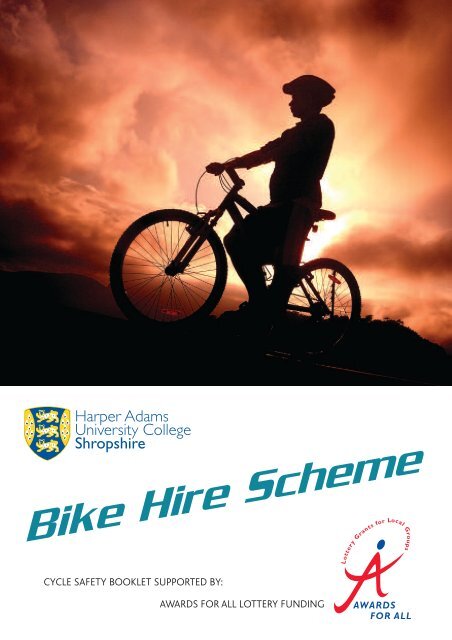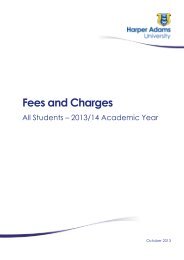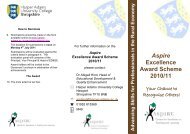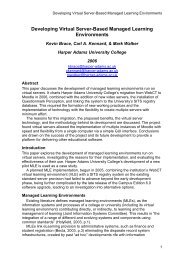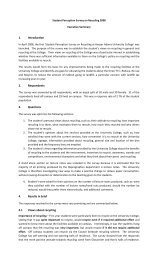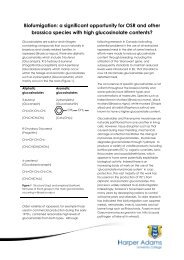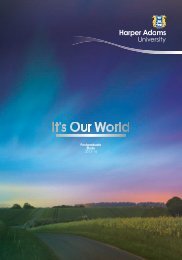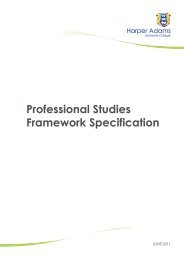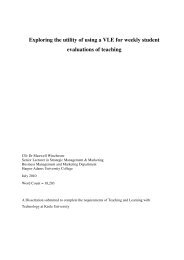Bike Hire Scheme Booklet - Harper Adams University College
Bike Hire Scheme Booklet - Harper Adams University College
Bike Hire Scheme Booklet - Harper Adams University College
You also want an ePaper? Increase the reach of your titles
YUMPU automatically turns print PDFs into web optimized ePapers that Google loves.
<strong>Harper</strong> <strong>Adams</strong><br />
<strong>University</strong> <strong>College</strong><br />
Shropshire<br />
<strong>Bike</strong> <strong>Hire</strong> <strong>Scheme</strong><br />
CYCLE SAFETY BOOKLET SUPPORTED BY:<br />
AWARDS FOR ALL LOTTERY FUNDING
INTRODUCTION<br />
This booklet has been commissioned by the ‘<strong>Bike</strong> <strong>Hire</strong> <strong>Scheme</strong>’<br />
run by the Student Services Department at <strong>Harper</strong> <strong>Adams</strong><br />
<strong>University</strong> <strong>College</strong>, Shropshire.<br />
Improving transport sustainability and providing greater<br />
choice for students and staff became achievable in 2008<br />
through grant funding obtained by the Sustainable<br />
Technologies Network based at <strong>Harper</strong> <strong>Adams</strong>. The<br />
funding was granted under the ‘Awards for All’,<br />
programme, which forms part of The National Lottery<br />
who provide‘Lottery funds for local groups’. Monies from<br />
the grant were used towards new bikes, helmets, locks,<br />
pumps, bike pods, cycle safety booklets and trail maps.<br />
Full details of the terms and conditions of the <strong>Harper</strong><br />
<strong>Adams</strong> ‘<strong>Bike</strong> <strong>Hire</strong> <strong>Scheme</strong>’ can be found at www.harperadams.ac.uk/student_services<br />
or by telephoning the<br />
Student Services Reception on 01952 815396. A full<br />
set of terms and conditions setting out eligibility and<br />
criteria for use, maintenance, insurance, disclaimer, late<br />
return and cycle proficiency etc can also be viewed at<br />
www.harper-adams.ac.uk/student_services<br />
as well as membership instructions for<br />
the scheme.<br />
Trail maps of cycle routes in and around <strong>Harper</strong> <strong>Adams</strong><br />
<strong>University</strong> <strong>College</strong> is also available from Student Services.<br />
Whether you just wish to borrow a bike to travel around<br />
the college campus or cycle to and from your<br />
accommodation or enjoy the local area, the Student<br />
Services and Sustainable Technologies teams at <strong>Harper</strong><br />
<strong>Adams</strong> wish you a happy, safe and healthy biking<br />
experience and hope this booklet provides some of the<br />
answers to any queries you may have.<br />
“Dave Mellor Cycles are pleased to support the <strong>Harper</strong><br />
<strong>Adams</strong> <strong>University</strong> <strong>College</strong> <strong>Bike</strong> <strong>Hire</strong> <strong>Scheme</strong> and the Cycle<br />
Safety Initiative”.<br />
02 <strong>Harper</strong> <strong>Adams</strong> <strong>University</strong> <strong>College</strong>
CONTENTS<br />
Giant CRS 4.0 from Dave Mellor Cycles,<br />
Shrewsbury.<br />
04 <strong>Bike</strong> <strong>Hire</strong> <strong>Scheme</strong> at <strong>Harper</strong> <strong>Adams</strong><br />
06 Adjusting your bike to suit you<br />
06 Cycling Techniques<br />
06 Starting out on your journey<br />
07 Safety Clothing & Helmets<br />
07 Cycling Accessories<br />
08 Cycling in different conditions<br />
09 Rules for Cyclists – Cycling on<br />
Roads<br />
11 Rules for Cyclists – Cycling on cycle<br />
lanes, tracks and paths etc<br />
12 Route from <strong>College</strong> to Newport and<br />
useful contact numbers<br />
Cycle Safely<br />
03
HARPER ADAMS BIKE HIRE SCHEME<br />
The Student Services Staff are available and happy to explain the scheme<br />
and answer any questions that may arise.A short resume of the scheme is given<br />
below but full terms and conditions and membership details are available from<br />
www.harper-adams.ac.uk/student_services or by contacting Student Services on<br />
01952 815396.The terms and conditions contain a declaration of agreement<br />
which will need to be signed prior to bike hire.<br />
Eligibility for <strong>Scheme</strong><br />
• Cycles may only be used by staff and students who are<br />
respectively employed by or registered with <strong>Harper</strong><br />
<strong>Adams</strong> <strong>University</strong> <strong>College</strong>.<br />
• Loans of cycles will initially be for a period of 1 week.<br />
• Cycles can only be booked up to 7 days in advance.<br />
• Any cycle issued to a member of staff or student can<br />
only be used by that particular member of staff or<br />
student.<br />
• Cycles must not be ridden whilst under the influence of<br />
alcohol or illegal substances.<br />
Membership of <strong>Scheme</strong><br />
• Staff/students will need to provide their current and<br />
valid Staff/Student ID Card and a deposit 1 which will be<br />
refunded on return of the cycle in good condition.<br />
• Return the cycle in the same condition as originally<br />
borrowed at the end of the loan period to the relevant<br />
dedicated cycle pod. (All cycles must be checked by a<br />
porter before being return to the pod. They can be<br />
contacted on 01952 815321 or porters@harperadams.ac.uk<br />
to book a time to get the cycle checked).<br />
• Return the bike lock keys, pod key and cycle check form,<br />
to the Student Services Receptionist.<br />
1<br />
The refundable deposit fee is detailed on the website or by<br />
contacting Student Services but has not been included in this<br />
booklet in case it may need to be changed from time to time.<br />
Maintenance<br />
• The cycles are checked and maintained so as to be in<br />
roadworthy condition on a planned preventative basis<br />
at bi-monthly intervals.<br />
• Users must not under any circumstance take a cycle<br />
out in the knowledge that a fault is present. Brakes,<br />
lights, tyres and free movement of wheels and pedals<br />
must be checked by the user before commencing use.<br />
All faults must be reported immediately by the user to<br />
the Student Services Receptionist, either upon initial<br />
inspection by the user or at any time subsequently as<br />
soon as the user becomes aware of a fault.<br />
Insurance<br />
• The cycles are insured for theft and accidental damage<br />
but with a £50.00 excess payable by the user in the<br />
event of any claim arising in relation to a cycle<br />
whilst loaned by the user. The cycles are provided<br />
with locks and must be fully locked to a secure cycle<br />
parking stand, whenever left unattended except if kept<br />
overnight at the user’s private address, when the cycle<br />
must be kept in a secure locked area.<br />
• If a bike is stolen, the user must report it immediately<br />
upon becoming aware of this to either the Student<br />
Services Receptionist (01952 815395) 9am - 5pm<br />
or Security (07980 061128) after 5pm.<br />
• If a cycle is stolen from the user’s private address,<br />
evidence must be produced by the user sufficient to<br />
prove forced or violent entry before a claim can be<br />
considered. All claims will be subject to the terms and<br />
conditions of the insurance.These can be inspected by<br />
a user upon application to the Director of Corporate<br />
Affairs.<br />
04 <strong>Harper</strong> <strong>Adams</strong> <strong>University</strong> <strong>College</strong>
Disclaimer:<br />
• Users of the cycles shall abide by the Highway Code at<br />
all times. <strong>Harper</strong><strong>Adams</strong> <strong>University</strong> <strong>College</strong> shall not<br />
be liable for any injury or loss, whatsoever, in<br />
relation to use or loan of a cycle, except in relation<br />
to death or personal injury arising from the<br />
<strong>University</strong>’s negligence. Any injury or loss resulting<br />
from, or arising in connection with the reckless,<br />
careless or improper use of a cycle by a user shall<br />
be borne by such user. Users have a duty to report<br />
any damage or faults relating to the cycles immediately,<br />
so that they can be maintained in a roadworthy<br />
condition.<br />
• If any damage is sustained to a cycle while in the<br />
possession of a user (beyond reasonable wear and tear)<br />
then the user will be liable for the cost of any repair<br />
required; this will either be deducted from the deposit<br />
paid or an invoice will be raised accordingly by the<br />
<strong>College</strong>.<br />
Redress for Late Return:<br />
• The success of the bike hire scheme depends on cycles<br />
being available to the maximum potential number of<br />
users. To encourage this and also to compensate the<br />
<strong>College</strong> for being unable to allocate a cycle to another<br />
user whilst overdue, fees will be levied and up to date<br />
rates are set out in the latest terms and conditions<br />
available at the web address below or by contacting<br />
Student Services on 01952 815396.<br />
Cycling Training and Proficiency – Wearing of<br />
Helmets<br />
A Cycling Proficiency <strong>Scheme</strong> will be operated routinely<br />
and all cycle users are strongly encouraged to avail<br />
themselves of this service. For enhanced personal safety,<br />
users are encouraged to wear a helmet. This can be<br />
borrowed free with the loan of a cycle for use by the user.<br />
Users who do not return with the cycle such helmet<br />
or return it in a damaged condition will pay on<br />
demand a £25.00 compensatory charge to the<br />
<strong>College</strong>.<br />
Cycle Routes & Maps<br />
A separate leaflet called ‘Cycling around <strong>Harper</strong>’ details<br />
the main cycle route from <strong>Harper</strong> <strong>Adams</strong> <strong>University</strong><br />
<strong>College</strong> to Newport which is a route clearly marked with<br />
blue signs. It also highlights 3 other routes in and around<br />
the <strong>College</strong> that cyclists may wish to follow.<br />
A full set of routes available for cyclists is contained in<br />
the Telford & Wrekin Council ‘Walking/<br />
Cycling Route Map’ which is either<br />
available from Student Services or<br />
by emailing Telford & Wrekin direct<br />
on nick.kitchen@telford.gov.uk<br />
www.harper-adams.ac.uk/student_services<br />
Cycle Safely<br />
05
Adjusting your<br />
bike to suit you<br />
Cycling techniques<br />
Highway Code – Rule 66<br />
Seat height<br />
This should be set so that your leg<br />
is almost straight when you’re<br />
sitting on the saddle with one heel<br />
on the pedal at its lowest point.<br />
Note: too low can be hard on the<br />
knees, too high can be bad for the<br />
lower back.<br />
Seat position<br />
This can be adjusted forwards or<br />
backwards using an allen key. As a<br />
general rule, your kneecap should<br />
be directly above the mid-point of<br />
the pedal when the pedal is at its<br />
furthest point forward. The saddle<br />
should be level, or tilted forward<br />
very slightly for greater comfort.<br />
Handlebars<br />
The reach, angle and height can all<br />
be adjusted either with a spanner<br />
or Allen key, or by changing the<br />
stem. It's worth remembering that<br />
a more upright riding position will<br />
help you look around more easily,<br />
either in traffic or just to enjoy the<br />
view. With a properly sized and<br />
adjusted bike you will avoid most<br />
discomfort and injury. However,<br />
you may need to persist with<br />
minor alterations until the bike fits<br />
perfectly or visit a bike shop for<br />
advice.<br />
You should:<br />
• Keep both hands on the handlebars<br />
except when signalling or changing<br />
gear.<br />
• Keep both feet on the pedals.<br />
• Be considerate of other road users,<br />
particularly blind and partially<br />
sighted pedestrians.<br />
• Let them know you are there when<br />
necessary, for example, by ringing<br />
your bell.<br />
You must not:<br />
• Ride more than two abreast, and<br />
ride in single file on narrow or busy<br />
roads and when riding round bends.<br />
• Ride close behind another vehicle.<br />
• Carry anything which will affect<br />
your balance or may get tangled up<br />
with your wheels or chain.<br />
Starting Out on your Journey<br />
Check list:<br />
• Essential items: cycle helmet, lights,<br />
a pump, gloves for winter cycling,<br />
puncture repair kit, lock.<br />
• Longer-distance cycling: padded<br />
shorts or underpants, layers of<br />
clothing, water bottle, snacks,<br />
maps.<br />
• All-weather cycling: waterproof<br />
jacket and trousers, reflective<br />
clothing.<br />
Safety Clothing<br />
Highway Code - Rule 59<br />
What you should wear to keep safe:<br />
• A cycle helmet which conforms to<br />
current regulations is the correct<br />
size and securely fastened.<br />
• Appropriate clothes for cycling.<br />
Avoid clothes which may get<br />
tangled in the chain, or in a wheel<br />
or may obscure your lights.<br />
• Light-coloured or fluorescent<br />
clothing which helps other road<br />
users to see you in daylight and<br />
poor light.<br />
• Reflective clothing and/or reflective<br />
accessories (belt, arm or ankle<br />
bands) that glow in the dark.<br />
06 <strong>Harper</strong> <strong>Adams</strong> <strong>University</strong> <strong>College</strong>
Cycling Clothes<br />
Tops<br />
On longer journeys, several layers<br />
will allow you to adjust to different<br />
temperatures.T-shirts, thermal vests<br />
and jackets should be long enough<br />
to cover your back. A fleece is ideal<br />
for keeping warm on chilly days and<br />
a shower/waterproof top with zips<br />
(to help adjust to temperature<br />
changes) can be packed in your bag<br />
just in case. Breathable waterproof<br />
clothes tend to be expensive, but are<br />
a good investment for regular<br />
cyclists offering maximum protection<br />
while allowing sweat to escape.<br />
Shorts & trousers<br />
Padded cycling shorts or underpants,<br />
whether loose or lycra, can guard<br />
against discomfort on long journeys<br />
and are available in male and female<br />
versions. Leggings or tracksuit<br />
trousers can go over these in the<br />
cold weather and a pair of<br />
waterproof trousers is essential if<br />
you intend to cycle in all conditions.<br />
Gloves<br />
Your hands are much more<br />
susceptible to cold on a bike than<br />
when you are out walking so a pair<br />
of gloves is a must in winter.<br />
Shoes<br />
Trainers or everyday shoes are fine<br />
for most journeys, although<br />
specialised shoes which clip into the<br />
pedals are available for the really<br />
dedicated.<br />
Helmets<br />
A helmet is necessary to provide<br />
vital protection if you fall off your<br />
bike.The helmet provided by <strong>Harper</strong><br />
<strong>Adams</strong> <strong>University</strong> <strong>College</strong> carries a<br />
CE mark and abides by the safety<br />
standards SNELL, B90/B95. It is<br />
essential that it is comfortable and<br />
fitted correctly – a badly fitted<br />
helmet can be a liability not a<br />
protection.<br />
Cycling Accessories<br />
Water bottle<br />
When cycling long distances, or in<br />
warm weather, it is possible to<br />
become dehydrated so don’t forget<br />
to take plenty of liquid. Bottle<br />
carriers that fit to the bike frame are<br />
available cheaply from bike shops<br />
together with bottles, but you can<br />
usually take one litre plastic squash<br />
bottles.<br />
Snacks for long journeys<br />
You’ll burn up plenty of energy on a<br />
long cycle trip, so remember to carry<br />
some spare food.<br />
Maps/guidebooks<br />
There is a local guide for the area<br />
around <strong>Harper</strong> <strong>Adams</strong> <strong>University</strong><br />
<strong>College</strong> and also a number of routes<br />
available on the following website<br />
www.sustrans.org.uk for a range<br />
of maps and guides to buy on-line.<br />
Additionally Telford & Wrekin<br />
Council have their own ‘Walking &<br />
cycling Map’ available by emailing<br />
nick.kitchen@telford.gov.uk<br />
Spare clothes<br />
On day trips, pack an extra layer as<br />
your body temperature may drop<br />
when you stop for a break.<br />
Lock it securely or you<br />
could lose it<br />
Lock<br />
This can be a cable lock, a chain with<br />
padlock or ideally a rigid metal D-<br />
lock<br />
Carriers/holdalls<br />
For small loads, a bum bag will<br />
suffice and small rucksacks are fine<br />
for carrying light loads but can make<br />
you hot. For heavier loads it’s<br />
advisable to invest in some panniers.<br />
These are specially adapted bags<br />
that fit onto a cycle rack usually<br />
fitted over the rear wheel. Front<br />
racks and panniers are available and<br />
are useful if you have a child seat on<br />
the back of your bike or when<br />
combined with rear panniers for<br />
cycle touring. Barbags that fit onto<br />
the handlebars or pouches mounted<br />
underneath the saddle are useful for<br />
maps, money and tools – but<br />
remember to remove these from<br />
your bike when locking up.<br />
Pumps<br />
You will usually have to buy this<br />
essential tool separately. There are<br />
two basic types of tyre valve: the<br />
traditional Presta valve and the<br />
wider Schraeder valve (like that on a<br />
car tyre). Make sure you get a pump<br />
that fits the right type of valve – or<br />
choose one that fits both types.<br />
Inflate your tyres to the<br />
recommended pressure specified on<br />
them (e.g. 60psi). Correctly inflated<br />
tyres make cycling a lot easier,<br />
improve handling and reduce the risk<br />
of punctures.<br />
Cycle Safely<br />
07
Cycling in different conditions<br />
Check list:<br />
• Cycling at night: use lights and<br />
reflective clothing.<br />
• Cycling in wet weather: wear bright<br />
clothing and consider using your<br />
lights; use waterproof clothing;<br />
check your bike especially brakes,<br />
tyres and gears, more regularly.<br />
• Cycling in very hot conditions: wear<br />
cool cotton clothes and use suntan<br />
cream; drink plenty.<br />
Cycling at night<br />
Lights –What lights your bike should<br />
have at night.<br />
Highway Code Rule 60<br />
At night your cycle MUST have<br />
white front and red rear lights lit.<br />
It MUST also be fitted with a red rear<br />
reflector and amber pedal reflectors.<br />
White front reflectors and spoke<br />
reflectors will also help you to be<br />
seen.<br />
Flashing lights are permitted but it is<br />
recommended that cyclists who are<br />
riding in areas without street lighting<br />
use a steady front lamp.<br />
Most lights are designed to be quick<br />
release so try to remove them when<br />
leaving your bike.<br />
Cycling in the wet<br />
Stay visible<br />
Once again, being visible is a key<br />
safety concern – bright fluorescent<br />
clothing is recommended, particularly<br />
for on-road cycling, and you<br />
should consider using your lights. It<br />
is advisable to wear bright reflective<br />
clothing when cycling at night. A<br />
reflective jacket or waistcoat that<br />
slips over your coat will help to<br />
define your shape in the dark.<br />
Reflective patches, badges, tape and<br />
stickers can be applied anywhere on<br />
the bike or rider, and are<br />
recommended to maximise your<br />
visibility.<br />
Keeping dry<br />
Light, well ventilated, waterproof<br />
jackets and trousers that can be<br />
slipped over your standard clothes<br />
are essential items for all-weather<br />
cyclists. Breathable waterproof<br />
products are more expensive, but<br />
will help keep you cool and dry, and<br />
for the really dedicated, it is possible<br />
to get waterproof shoe protectors.<br />
Keeping your bike maintained<br />
Rain will wash away the oil that<br />
provides essential lubrication so you<br />
may need to check items such as<br />
chain and gears on a daily basis<br />
during a spell of bad weather. Make<br />
sure your brakes are in top condition,<br />
tyres well pumped and remember<br />
that it takes longer to stop in the<br />
wet.<br />
Cycle carefully<br />
While roads in general will become<br />
more slippery in the rain, surfaces<br />
such as painted road markings and<br />
metal plates can provide very little<br />
friction in the rain and can be<br />
extremely hazardous. Avoid applying<br />
your brakes too sharply – instead,<br />
cycle more slowly and carefully,<br />
especially down hills and around<br />
corners. Where there is mud, slow<br />
down or get off the bike and walk<br />
around.<br />
Cycling in very hot weather<br />
It’s not usually necessary to take any<br />
special precautions for short<br />
everyday trips. However, on longer<br />
journeys, remember to use suntan<br />
lotion or to cover your arms and the<br />
back of your neck. It’s also advisable<br />
to drink plenty of water to avoid<br />
dehydration and take extra clothes<br />
for when you stop and may cool<br />
down.<br />
08 <strong>Harper</strong> <strong>Adams</strong> <strong>University</strong> <strong>College</strong>
RULES FOR CYCLISTS – Cycling on Roads<br />
Check list:<br />
Highway Code - Rule 64<br />
• Follow the Highway Code – in<br />
particular, don’t jump traffic lights<br />
or cycle on pavements (except<br />
where designated).<br />
• Use clear signals at all times, so<br />
that other road users are in no<br />
doubt as to what you intend to do.<br />
Highway Code - Rule 69<br />
• Obey all traffic signs and traffic<br />
light signals.<br />
Highway Code - Rule 71<br />
• Do not cross the stop line when<br />
traffic lights are red. Some<br />
junctions may have an advanced<br />
stop line to enable you to wait and<br />
position yourself ahead of other<br />
traffic.<br />
• Use clear signals at all times, so<br />
that other road users are in no<br />
doubt as to what you intend to do.<br />
• At night, ensure that motorists can<br />
see you by using lights and wearing<br />
reflective clothing. (It’s a good idea<br />
to wear reflective clothing during<br />
the day in urban settings, where<br />
there is heavy traffic.)<br />
• In wet weather, take care and<br />
watch your speed. Surfaces may be<br />
slippery and it will take longer to<br />
stop.<br />
• At junctions, gaining eye contact<br />
with other road users is a good way<br />
of ensuring that they have seen<br />
you.<br />
You should:<br />
Highway Code – Rule 67<br />
• Look all around before moving<br />
away from the kerb, turning or<br />
manoeuvring, to make sure it is<br />
safe to do so. Give a clear signal to<br />
show other road users what you<br />
intend to do.<br />
• Look well ahead for obstructions in<br />
the road, such as drains, pot-holes<br />
and parked vehicles so that you do<br />
not have to swerve suddenly to<br />
avoid them. Leave plenty of room<br />
when passing parked vehicles and<br />
watch out for doors being opened<br />
or pedestrians stepping into your<br />
path.<br />
• Be aware of traffic coming up<br />
behind you.<br />
• Take extra care near road humps,<br />
narrowings and other traffic<br />
calming features.<br />
• Take care when overtaking.<br />
You must not:<br />
Highway Code – Rule 68<br />
• Carry a passenger unless your cycle<br />
has been built or adapted to carry<br />
one.<br />
• Hold onto a moving vehicle or<br />
trailer.<br />
• Ride in a dangerous, careless or<br />
inconsiderate manner.<br />
• Ride when under the influence of<br />
drink or drugs, including medicine.<br />
Cycle Safely<br />
09
Road junctions<br />
Highway Code – Rules 72-75<br />
• On the left. When approaching a<br />
junction on the left, watch out for<br />
vehicles turning in front of you, out<br />
of or into the side road. Just before<br />
you turn, check for undertaking<br />
cyclists or motorcyclists. Do not<br />
ride on the inside of vehicles<br />
signalling or slowing down to turn<br />
left.<br />
• Pay particular attention to long<br />
vehicles which need a lot of room<br />
to manoeuvre at corners. Be aware<br />
that drivers may not see you.They<br />
may have to move over to the right<br />
before turning left. Wait until they<br />
have completed the manoeuvre<br />
because the rear wheels come very<br />
close to the kerb while turning. Do<br />
not be tempted to ride in the space<br />
between them and the kerb.<br />
• On the right. If you are turning<br />
right, check the traffic to ensure it<br />
is safe, then signal and move to the<br />
centre of the road.Wait until there<br />
is a safe gap in the oncoming traffic<br />
and give a final look before<br />
completing the turn. It may be<br />
safer to wait on the left until there<br />
is a safe gap or to dismount and<br />
push your cycle across the road.<br />
• Dual carriageways. Remember that<br />
traffic on most dual carriageways<br />
moves quickly.When crossing wait<br />
for a safe gap and cross each<br />
carriageway in turn.Take extra care<br />
when crossing slip roads.<br />
Roundabouts<br />
Highway Code – Rules 77-78<br />
• You may feel safer walking your<br />
cycle round on the pavement or<br />
verge. If you decide to ride round<br />
keeping to the left-hand lane you<br />
should be aware that drivers may<br />
not easily see you.<br />
• Take extra care when cycling across<br />
exits.<br />
• You may need to signal right to<br />
show you are not leaving the<br />
roundabout.<br />
• Watch out for vehicles crossing<br />
your path to leave or join the<br />
roundabout.<br />
• Give plenty of room to long<br />
vehicles on the roundabout as they<br />
need more space to manoeuvre.<br />
Do not ride in the space they need<br />
to get round the roundabout. It<br />
may be safer to wait until they<br />
have cleared the roundabout.<br />
Crossings<br />
Highway Code – Rules 79-82<br />
• Do not ride across equestrian<br />
crossings, as they are for horse<br />
riders only. Do not ride across a<br />
pelican, puffin or zebra crossing.<br />
Dismount and wheel your cycle<br />
across.<br />
• Toucan crossings. These are lightcontrolled<br />
crossings which allow<br />
cyclists and pedestrians to share<br />
crossing space and cross at the<br />
same time. They are push-button<br />
operated. Pedestrians and cyclists<br />
will see the green signal together.<br />
Cyclists are permitted to ride<br />
across.<br />
• Cycle-only crossings. Cycle tracks<br />
on opposite sides of the road may<br />
be linked by signalled crossings.You<br />
may ride across but you MUST<br />
NOT cross until the green cycle<br />
symbol is showing.<br />
• Level crossings/Tramways. Take<br />
extra care when crossing the tracks.<br />
You should dismount at level<br />
crossings where a‘cyclist dismount’<br />
sign is displayed.<br />
10 <strong>Harper</strong> <strong>Adams</strong> <strong>University</strong> <strong>College</strong> 010
Cycling on cycle lanes, tracks and paths etc:<br />
Highway Code – Rules 61, 62, 63, 65<br />
Check list:<br />
• Keep to your side of any dividing<br />
line (but if in doubt, keep left).<br />
• Give way to pedestrians, horse<br />
riders and wheelchair users and<br />
acknowledge/thank those that give<br />
way to you.<br />
• Do not expect to cycle at high<br />
speeds and be prepared to slow<br />
down or stop if necessary.<br />
• Take special care at junctions,<br />
bends and entrances.<br />
• Fix a bell to your bike and use it to<br />
warn of your approach. However,<br />
remember that some people are<br />
hard of hearing or visually impaired<br />
so don’t assume they can see or<br />
hear you.<br />
Cycle Routes and Other<br />
Facilities<br />
Use cycle routes, advanced stop<br />
lines, cycle boxes and toucan<br />
crossings unless at the time it is<br />
unsafe to do so. Use of these<br />
facilities is not compulsory and will<br />
depend on your experience and skills,<br />
but they can make your journey<br />
safer.<br />
Cycle Tracks<br />
These are normally located away<br />
from the road, but may occasionally<br />
be found alongside footpaths or<br />
pavements. Cyclists and pedestrians<br />
may be segregated or they may<br />
share the same space (unsegregated).When<br />
using segregated<br />
tracks you MUST keep to the side<br />
intended for cyclists as the<br />
pedestrian side remains a pavement<br />
or footpath 2 . Take care when<br />
passing pedestrians, especially<br />
children, older or disabled people,<br />
and allow them plenty of room.<br />
Always be prepared to slow down<br />
and stop if necessary.Take care near<br />
road junctions as you may have<br />
difficulty seeing other road users,<br />
who might not notice you.<br />
Cycle Lanes<br />
These are marked by a white line<br />
(which may be broken) along the<br />
carriageway (see Rule 140). Keep<br />
within the lane when practicable.<br />
When leaving a cycle lane check<br />
before pulling out that it is safe to do<br />
so and signal your intention clearly<br />
to other road users. Use of cycle<br />
lanes is not compulsory and will<br />
depend on your experience and skills,<br />
but they can make your journey<br />
safer.<br />
Public Footpaths<br />
Public footpaths are for pedestrians<br />
and wheelchair users only. It is illegal<br />
to cycle on a footpath unless<br />
permission has been granted by the<br />
landowner to use it as a shared use<br />
path.<br />
Bus Lanes<br />
Most bus lanes may be used by<br />
cyclists as indicated on signs.Watch<br />
out for people getting on or off a<br />
bus. Be very careful when overtaking<br />
a bus or leaving a bus lane as you<br />
will be entering a busier traffic flow.<br />
Do not pass between the kerb and a<br />
bus when it is at a stop.<br />
Bridleways<br />
Public bridleways can be used by<br />
walkers, horse riders, wheelchair<br />
users and cyclists. However, by law,<br />
cyclists should give way to other<br />
users. Bridleways may not have been<br />
specifically designed for cycle use, so<br />
surfaces may be poor. Whenever<br />
cycling near horse riders ensure you<br />
indicate your presence by using your<br />
bell or calling out.<br />
Shared use paths<br />
Shared use paths are those<br />
designated for use by pedestrians,<br />
cyclists, and in some cases horse<br />
riders. These are usually free of<br />
motor traffic and are specifically<br />
designed for the different users, so<br />
surfaces should be good. Permissive<br />
shared use paths include sections of<br />
canal towpaths, forest tracks, disused<br />
railways, footpaths and routes<br />
adjacent to footpaths. Many of the<br />
traffic-free sections of the National<br />
Cycle Network use shared use paths.<br />
2<br />
For example when using the cycle lane<br />
along the left hand side of B5062 Edgmond<br />
Road approaching Chaney Hill from Newport<br />
to <strong>Harper</strong> <strong>Adams</strong> <strong>University</strong> <strong>College</strong>.<br />
Cycle Safely 11
Longwithy Lane<br />
Adeney Road<br />
High Street<br />
Hillside School Rd<br />
Stackyard Lane<br />
Edgmond<br />
Flatt Rd<br />
B5062 Shrewsbury Road<br />
Cycle trail to Newport<br />
<strong>Harper</strong> <strong>Adams</strong><br />
<strong>University</strong> <strong>College</strong><br />
Shropshire<br />
The trail<br />
starts<br />
here<br />
The<br />
Lamb Inn<br />
High Street<br />
Robin Lane<br />
Chetwynd Road<br />
Longford Road<br />
Newport Road<br />
B5062 Shrewsbury Road<br />
Longford Road<br />
Newport<br />
Salters Lane<br />
Lower Bar<br />
St. Nicholas<br />
Church<br />
Water Lane<br />
Chetwynd End<br />
David Turner<br />
Cars<br />
Shell<br />
Forton Road<br />
For further information<br />
See www.harper-adams.ac.uk/student_services<br />
Contact 01952 815396 (Student Services)<br />
Useful reference<br />
www.thecycleshop.co.uk – Dave Mellor Cycles, Shrewsbury<br />
www.direct.gov.uk – Highway Code<br />
www.sustrans.org.uk – Sustrans


